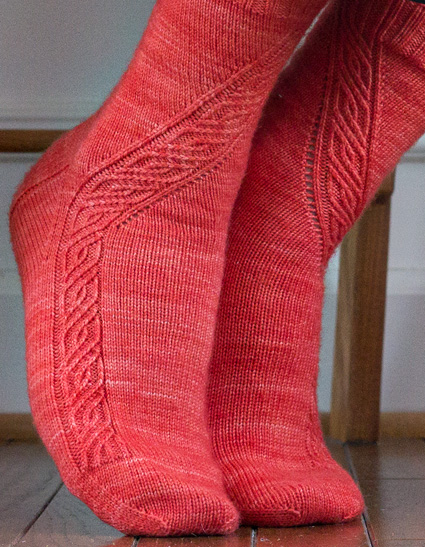

|
|
|

Angular velocity specifies rotational speed. Specifically, it is the rate of change of angular displacement and is a vector quantity (more precisely, a pseudovector) which specifies the angular speed (rotational speed) of an object and the axis about which the object is rotating. The cables, inspired by an Alpine stitch dictionary that found its way into my house, may look intimidating, but really they're not. After a few rounds, you'll see that they always move in the same direction. With a few yarn overs and stockinette between the cables, these socks can work up pretty quickly.
|
||
|
SIZE |
|
|
FINISHED MEASUREMENTS |
|
MATERIALS Notions |
|
GAUGE |
| 28 sts/48 rounds = 4 inches in stockinette 30 sts/48 rounds = 4 inches in pattern |
|
PATTERN NOTES |
|
Instructions for grafting can be found here. Working the Cables with a cable needle Working the Cables without a cable needle: T2L – With the right-hand needle in back of the work, skip the first stitch on the left-hand needle and insert the tip of the needle into the back leg of the second stitch. Drop both of the stitches off of the left-hand needle. The first stitch will fall free. Insert the left needle into the dropped knit stitch, then slide the other stitch back onto the left needle. Knit the first stitch through the back loop, then knit the second stitch through the back loop. TP2L – With the right-hand needle in back of the work, skip the first stitch on the left-hand needle and insert the tip of the needle into the back leg of the second stitch. Drop both of the stitches off of the left-hand needle. The first stitch will fall free. Insert the left needle into the dropped knit stitch, then slide the other stitch back onto the left needle. Purl the first stitch, then knit the second stitch through the back loop. T2R – With the right-hand needle in front of the work, skip the first stitch on the left-hand needle and insert the tip of the needle into the second stitch purlwise. Drop both of the stitches off of the left needle. The first stitch will fall free. Insert the left needle into the dropped stitch, then slide the other stitch back onto the left needle. Knit the first stitch through the back loop, then knit the second stitch through the back loop. TP2R – With the right-hand needle in front of the work, skip the first stitch on the left-hand needle and insert the tip of the needle into the second stitch purlwise. Drop both of the stitches off of the left needle. The first stitch will fall free. Insert the left needle into the dropped stitch, then slide the other stitch back onto the left needle. Knit the first stitch through the back loop, then purl the second stitch. |
|
The charts for this pattern are very large and fit on a letter-sized page. Click here and print the resulting page. |
|
DIRECTIONS Right Sock Ribbing Round: (Work Right Rib Chart, working marked repeat 2[3, 4, 5] times) twice. Work appropriate Ribbing Round 18 times or until desired length. Leg Right Leg Rounds 1–11: (Work Row 1–11 of Right Leg Chart; k8[12, 16, 20]) twice. Left Leg Rounds 1-11: (K8[12, 16, 20]; work Row 1–11 of Left Leg Chart) twice. Repeat appropriate Leg Rounds 1–12 until desired length is reached, ending on round 12, including shift in start of round. Sample as shown has 6 repeats, and measures 7.5 inches long. Heel Flap Row 1 [WS]: Sl 1 wyif, p27[31, 35, 39], turn. Repeat these 2 rows 13[15, 17, 19] more times for a total of 28[32, 36, 40] rows in the heel flap. Turn the Heel Small Size Only: 18 sts rem. Proceed to Gusset. Gusset Gusset Round 2: Work instep sts in pattern as established; k1, ssk, k to 3 sts before end of round, k2tog, k1. 2 sts decreased. Gusset Round 3: Work instep sts in pattern as established; k to end of round. Rep Gusset Rounds 2 and 3 4 times more, and work Gusset Round 2 once more to complete the final row of Leg Chart. 62[72, 82, 92] sts. At this point, you will start to work the Foot Chart in place of the Leg chart. Gusset Round 13, Left Sock: K15[19, 23, 27]; work Left Foot Chart; k to end of round. Gusset Round 13, Right Sock: Work Right Foot Chart; k to end of round. Rep Gusset Rounds 13 and 14 2[3, 4, 5] more times until 28[32, 36, 40] sts rem on the sole. Foot Work even as set until the foot is 1.5[1.5, 1.75, 2] inches short of full foot length ending after row 12 of the Chart. If necessary work additional rounds of row 12 of the Chart to achieve desired length. Toe Round 2: Knit all sts. Repeat Rounds 1 and 2 6[7, 8, 9] more times until 28[32, 36, 40] total sts remain. Repeat Round 1 (decreasing every round) 3 times; 16[20, 24, 28] total sts remain. |
|
FINISHING |
| ABOUT THE DESIGNER |
|
Rich started knitting as a way to relieve stress. His first two projects were sweaters, since there was no one to tell him that perhaps a scarf would be a better starting point. At some point, Rich got it into his shiny, bald head that knitting socks might be a good idea. Rich lives in Northern Virginia with four cats who think that stitch markers solely exist to entertain them. He can be found online here and on Ravelry. |
|
Pattern & images © 2015 Rich Ensor. Contact Rich |